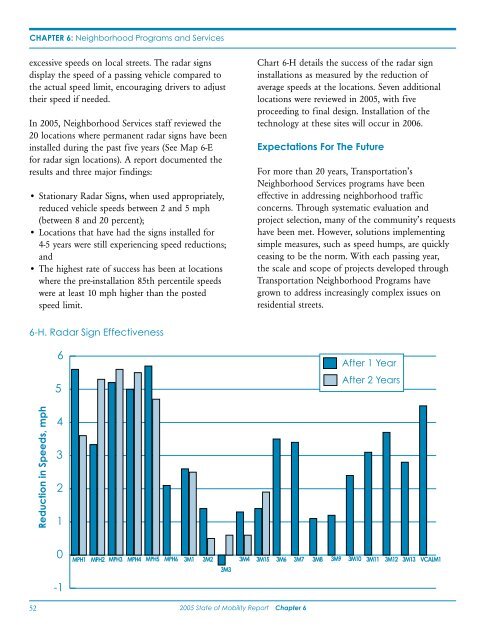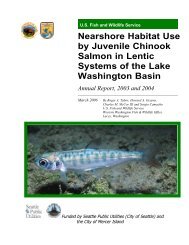2005 State of Mobility Report - City of Bellevue
2005 State of Mobility Report - City of Bellevue
2005 State of Mobility Report - City of Bellevue
You also want an ePaper? Increase the reach of your titles
YUMPU automatically turns print PDFs into web optimized ePapers that Google loves.
CHAPTER 6: Neighborhood Programs and Services<br />
excessive speeds on local streets. The radar signs<br />
display the speed <strong>of</strong> a passing vehicle compared to<br />
the actual speed limit, encouraging drivers to adjust<br />
their speed if needed.<br />
In <strong>2005</strong>, Neighborhood Services staff reviewed the<br />
20 locations where permanent radar signs have been<br />
installed during the past five years (See Map 6-E<br />
for radar sign locations). A report documented the<br />
results and three major findings:<br />
• Stationary Radar Signs, when used appropriately,<br />
reduced vehicle speeds between 2 and 5 mph<br />
(between 8 and 20 percent);<br />
• Locations that have had the signs installed for<br />
4-5 years were still experiencing speed reductions;<br />
and<br />
• The highest rate <strong>of</strong> success has been at locations<br />
where the pre-installation 85th percentile speeds<br />
were at least 10 mph higher than the posted<br />
speed limit.<br />
Chart 6-H details the success <strong>of</strong> the radar sign<br />
installations as measured by the reduction <strong>of</strong><br />
average speeds at the locations. Seven additional<br />
locations were reviewed in <strong>2005</strong>, with five<br />
proceeding to final design. Installation <strong>of</strong> the<br />
technology at these sites will occur in 2006.<br />
Expectations For The Future<br />
For more than 20 years, Transportation’s<br />
Neighborhood Services programs have been<br />
effective in addressing neighborhood traffic<br />
concerns. Through systematic evaluation and<br />
project selection, many <strong>of</strong> the community’s requests<br />
have been met. However, solutions implementing<br />
simple measures, such as speed humps, are quickly<br />
ceasing to be the norm. With each passing year,<br />
the scale and scope <strong>of</strong> projects developed through<br />
Transportation Neighborhood Programs have<br />
grown to address increasingly complex issues on<br />
residential streets.<br />
6-H. Radar Sign Effectiveness<br />
6<br />
5<br />
After 1 Year<br />
After 2 Years<br />
Reduction in Speeds, mph<br />
4<br />
3<br />
2<br />
1<br />
0<br />
MPH1 MPH2 MPH3 MPH4 MPH5 MPH6 3M1 3M2<br />
3M3<br />
3M4 3M15 3M6 3M7 3M8 3M9 3M10 3M11 3M12 3M13 VCALM1<br />
-1<br />
52<br />
<strong>2005</strong> <strong>State</strong> <strong>of</strong> <strong>Mobility</strong> <strong>Report</strong> Chapter 6

















